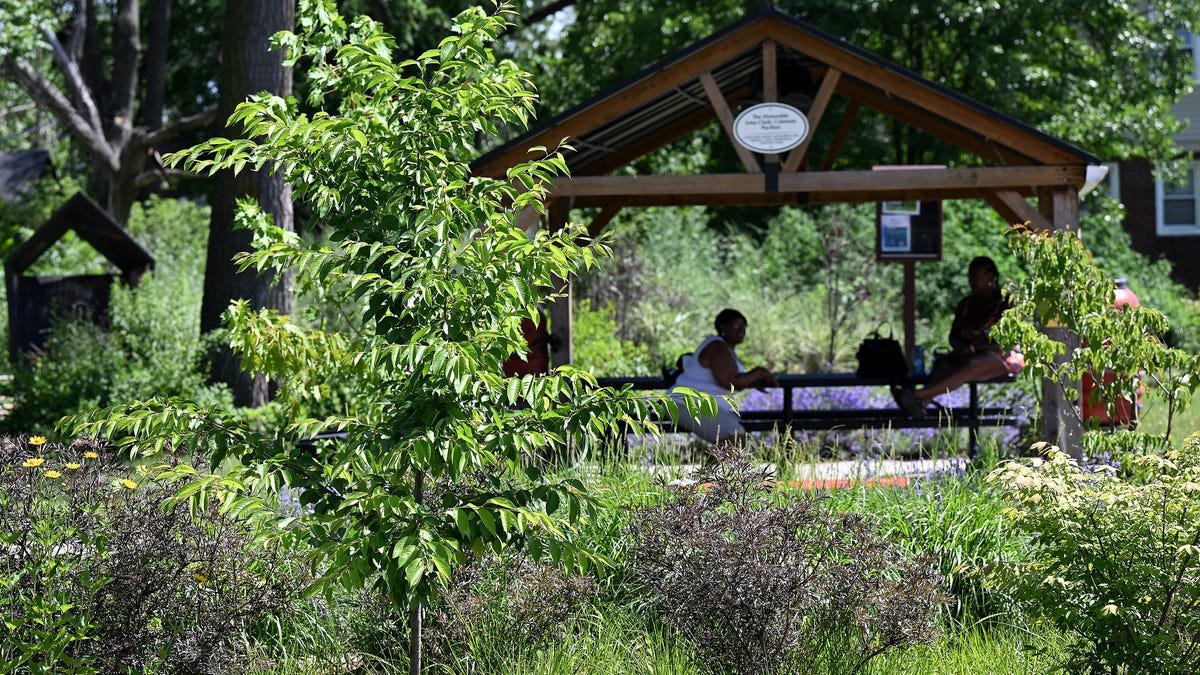Most of the more than 20K homes purchased by Detroit residents since 2014 have appreciated in value. But the gains are not evenly distributed across the city.
Detroit — More than half of homes purchased from the Detroit Land Bank Authority over the last decade have appreciated in value — some by tens of thousands of dollars — but the gains were not evenly distributed across the city.
Around 60% of the 20,000 residential properties the land bank sold since 2014 were worth more last year than their original sale price, according to a Detroit News analysis of every residential property sold by the land bank over the last decade and 2024 city tax assessment records.
In the historic Boston-Edison neighborhood, 36 land bank properties that sold for $35,000 on average saw their values increase by an average of $68,102, or about 195%, to more than $100,000. In Warrendale, where residents purchased nearly 500 homes for a little more than $5,500 on average, land bank property values increased by more than three times to $17,805.
“I think the appreciation we’ve seen in these homes speaks to the positive outcomes we’ve seen in returning these properties to productive use,” said Rob Linn, the land bank’s director of planning and analysis.
But in 18 neighborhoods — including Tireman (also called Midwest), where residents bought more land bank properties than anywhere else in the city — the average land bank property was worth about $7,500 less in 2024 than when it was purchased. Last year’s city tax assessments declared nearly a quarter of the parcels worthless.
When buyers fail to rehab their new homes, the land bank has the ability to reclaim them, taking the property off the market and driving its value down. Property assessments include a “mass appraisal” of a neighborhood, said Scott Vandemergel, Wayne County’s director of assessment and equalization. So when properties stay in poor condition and vacant, they lower the property values in the whole area. And they remain in the land bank’s inventory, which Vandemergel said can result in a low assessment.
“There is no real reason for something to go down after it’s been returned and economically viable,” he said.
Around 12% of all properties sold were back in the land bank’s inventory this year. Neighborhoods where fewer buyers kept their properties experienced sharper drops in their property values.
On paper, new homeowners have six months to turn on all utilities, replace a broken furnace or water heater and fix up the exterior of their house. In practice, said Reginald Scott, the chief financial officer and chief operating officer of the Land Bank Authority, most successful home buyers take 18-24 months to comply.
“I know there’s some kind of feeling about the land bank being able to claw back properties,” Scott said. “The last thing we want back is their property.”
Several city officials contend the land bank has been effective, but it’s far from the only factor in combating Detroit’s blighted and vacant housing stock.
“If you see property values increase, it’s not solely because of the land bank,” City Council President Pro Tem James Tate said. “It’s really part of the ecosystem, one of the tools that is used to transform neighborhoods.”
Land bank becomes a target
The analysis of how the values of former land bank properties have changed comes as the authority faces criticism about its operations, its lack of transparency with residents and a big cut in its operating subsidy from the city.
In April, the Detroit City Council voted to eliminate the land bank’s $10.5 million subsidy from its 2026 fiscal year budget that started Tuesday. Mayor Mike Duggan’s office criticized the DLBA’s tens of millions of dollars in reserve funds, and some council members raised questions about its continued relevance.
“We’ve given over $100 million in subsidies for the land bank. And what do we get for it? People that are homeless. A lot of angry residents,” said Detroit City Council member Mary Waters, a frequent critic of the land bank.
“If it were up to me, they would not be operating.”
Waters’ office said she is working to create a process to shut down the land bank and replace it with the creation of a community land trust, a nonprofit organization governed by public representatives and residents.
But land bank officials said they’ve done what they were supposed to do when the authority was created in 2008: Get vacant homes and lots back on the tax rolls.
“Our goal was to focus narrowly on returning properties back to productive use,” said Scott when asked about the canceled subsidy.
The loss of the subsidy led the land bank to reduce its workforce by around 20 staffers and streamline its operations, saving around $6 million. The authority is making up the rest of the 2026 shortfall from its $55 million fund balance.
What analysis shows
Since 2008, the city of Detroit has transferred ownership of foreclosed and abandoned properties to the land bank, one of the largest in the country, which in turn sells them to Detroit residents and developers. Beginning in 2014, the city transferred approximately 45,000 vacant parcels to the land bank, bringing its holdings to a total of 115,000. Land bank officials earlier this spring said they’ve whittled that number to 4,500 vacant homes, but they also have more than 60,000 vacant lots.
The News’ analysis shows more than half of those properties have increased in value, combining public data on land bank sales and property tax assessments for the first time.
In the last decade, 12,924 of the around 22,000 residential properties sold through the land bank’s auction, own-it-now and project programs increased in value. The average land bank property was sold for around $4,000 and valued at more than $11,000 in 2024, about a 275% increase.
Buyers purchased more than 1,000 land bank properties in Midwest/Tireman, an area hit hard by disinvestment and population loss in the 2000s. More than half of them have depreciated since their purchase date.
But in some neighborhoods, such as Schulze in northwest Detroit, more than 90% of land bank properties increased in value.
Outer-ring neighborhoods, such as Holcomb and Brightmoor, saw the greatest gains in property value, the analysis found, as well as areas where property values were higher overall.
For every $1 increase in the overall property value, the appreciation of land bank properties rose 34 cents, one statistical model found.
Not all sales programs are created equal. Homes purchased at auction typically cost more and were in better condition when they were sold. They gained more than $10,000 on average, twice as much as homes purchased through the own-it-now program.
“Our research shows that almost uniformly, our buyers are seeing a positive return on their purchase,” the land bank’s Linn said.
There are different situations where land bank buyers might see big gains, according to Wayne County’s Vandemergel.
“If there is a property that is in the land bank inventory in a stable, appreciating, maintained area, that would represent very substantial appreciation, because it’s a desirable area with underlying factors,” Vandemergel said.
He added, “If something is in a transitional area and it was being renovated,” homeowners might see “significant appreciation.”
Since the land bank sells properties far below typical market value, the barrier to entry is low. But the rehabilitation costs can be prohibitive, said David Dworkin, president and CEO of the National Housing Conference.
Dworkin, whose organization advocates for affordable housing, said Detroit’s aging housing stock comes with hidden costs. “If you need to rehab a home before you live there, the cost of that rehab can exceed the value of the home after it’s completed,” he said.
A ‘mixed bag’
The land bank’s programs — which include a buy-back program for people who might be living in one of their properties and other initiatives — have been a “mixed bag” for residents such as Jay Meeks, president of the Marygrove Community Association.
Meeks grew up in Marygrove; his mother still lives there. So when he had the opportunity to purchase a home in the neighborhood from the land bank in 2014, he jumped on it. After purchasing the property for $8,100, financed by taking out a loan on his car, Meeks benefited from an early DLBA partnership with Huntington Bank. The bank loaned him $25,000 for renovations, forgiving part of the loan after he stayed in the home longer than five years.
“I’m fortunate how I became a homeowner through this route,” Meeks said.
When he joined the MCA board in 2022, Meeks used his experience to lead the association’s Marygrove Civic Commons program.
To date, the MCA has turned vacant lots purchased from the land bank into pocket parks, an arboretum, a native wildflower meadow and produce gardens. In the gardens, the community grows fruit trees, and first-grade students at The School at Marygrove plant snap peas.
At times, dealing with the land bank has been a headache, Meeks said. One of the MCA’s initiatives, the Huntington Community Park, consists of five former vacant lots on one side and three on the other, with a single lot in between.
The association has been attempting to purchase the middle lot from the land bank since September 2022.
Another issue, Meeks said, is that “communication is just terrible.”
One MCA purchase — six lots for around $2,500 — took five months to finalize. The land bank representative shared incorrect information on three separate occasions during the process, Meeks said.
“I don’t know what the answer is, but this approach that worked out for me is not for everyone,” he said.
In a bid to improve customer service, Scott said the land bank is implementing an interactive phone system with chatbot features.
“Oftentimes, what you get the complaint about is that someone doesn’t meet the eligibility requirements and they don’t follow up with the land bank,” he said. “More often than not, it is the complexity of the issue or the parcel.”
Successful rehab on the east side
In 2017, Stephen Thornhill and Justin Hewitt purchased a home from the Detroit Land Bank Authority for just $1,000 in the city’s East English Village neighborhood on the city’s east side.
The duplex had seen better days. One of its brick walls buckled toward the outside, and the entire third floor was unfinished.
“Oh my gosh, what a nightmare,” Thornhill remembered thinking of the duplex.
Hewitt and several contractors did exhaustive renovations: They knocked down the faulty wall, gutted the kitchen and turned a first-floor bedroom into a dedicated library. Five years later, they had spent close to $120,000 on the project, but Thornhill said he expects they could sell the home for three times that amount.
East English Village is a land bank success story. Out of the 59 homes its residents have bought from the DLBA since 2014, 56 of them have appreciated in value. In 2024, they were assessed at more than $50,000 a piece, around five times as much as the original average sale price.
“The residents really care about the neighborhood and want the best for it,” said Greg Stolarski, the president of the East English Village neighborhood association.
Who owns former land bank properties?
In 19 neighborhoods — including East Village, Mexicantown and North End — corporations own most of the former land bank parcels. In the southwest Detroit neighborhood of Delray, just one of the 21 former land bank properties is owned by an individual. The rest are owned by the Michigan Department of Transportation, a church and two private developers.
Waters, the city council member, raised concerns about occupied properties “being bundled and sold to developers rather than prioritizing Detroiters.”
In one instance, she said, the DLBA asked the City Council to be allowed to bundle 42 homes and sell them to a developer.
When Waters’ staff visited the homes in question in 2023, 26 of them — more than half — were occupied. Waters said she saw “adult men crying, saying ‘my family and I aren’t going to have a place to live.’”
Today, property records show close to two out of every three residential properties sold by the land bank are owned by individuals. Developers, nonprofits and other entities own just over 20%, and 12% are back in the hands of the land bank.
Scott said most buyers — more than 80% — are Detroiters, many with annual incomes less than $40,000.
In Thornhill’s neighborhood, East English Village, more than 70% of former land bank properties are owned by individuals.
The neighborhood association’s president, Greg Stolarski, is proud of that fact.
“We want neighbors who own the properties living in it,” Stolarski said.
The DLBA celebrated having 12,000 rehabilitated housing units in March. Its focus has shifted, however, to the sale and maintenance of the more than 60,000 vacant lots in its inventory.
“The land bank doesn’t have 12,000 more units to sell,” Linn said. Instead, the DLBA hopes “to leverage its vacant land to catalyze new in-fill housing.”
The National Housing Conference’s Dworkin urged Mayor Mike Duggan’s successor to continue the work.
“I would encourage the next mayor and the council to recognize how successful it’s been and continue to invest,” he said as nine candidates compete in August’s primary election to replace Duggan.
Waters advised the city’s next mayor to “work closely with the land bank and make sure they put Detroiters first.”
“We need them to insist that it happens,” she said.
bwarren@detroitnews.com







